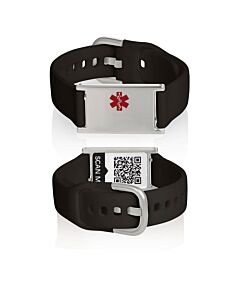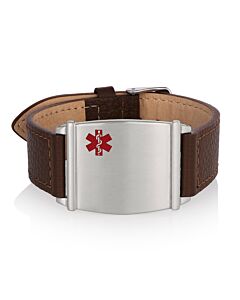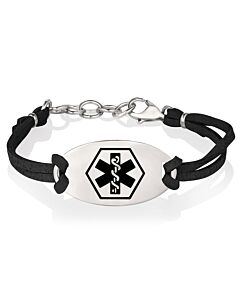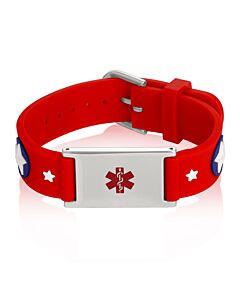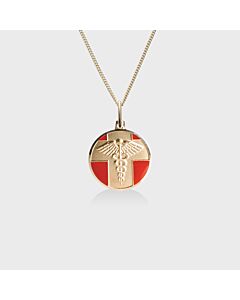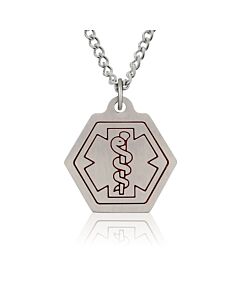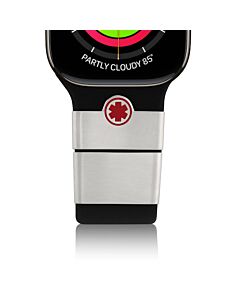

Medical Alert IDs for Latex Allergy
A latex allergy medical ID bracelet, wristband, or necklace is recommended for a latex allergy. A person who is diagnosed with latex allergy can experience mild to severe reactions when exposed to natural rubber latex. Their bodies mistake latex for a harmful substance and can sometimes go into anaphylaxis, a life-threatening condition that causes throat swelling and difficulty breathing.
Anyone that has a latex allergy should limit and avoid exposure to latex products. Wearing a medical ID can alert others of latex allergy and in case of an allergic reaction, quickly identify latex allergy as the cause of these symptoms.
"The best treatment for latex allergy is avoidance. If you have severe latex allergy reaction you should wear medical alert identification and carry an epinephrine (adrenaline) auto-injector for emergency treatment." - ACAAI
Severe Symptoms of Latex Allergy
When a person is highly allergic to latex, symptoms can be life threatening and lead to anaphylaxis or anaphylactic shock. These symptoms can make it difficult to communicate and alert others of their latex allergy. Unless a person wears some form of medical identification, these symptoms are at risk of being misdiagnosed and cause significant delay in receiving specialized care.
- Difficulty breathing
- Dizziness
- Confusion
- Nausea
- Vomiting
- Rapid or weak pulse
- Loss of consciousness
Source: Family Doctor
Medical IDs and Latex Allergy in Emergencies
According to Harvard Medical School, up to 6% of the general population may have a latex allergy or sensitivity. Latex allergy can be a tricky condition to have, as most medical personnel wear latex gloves while handling patients. Besides being in contact with the latex in rubber gloves, a person may be exposed by inhaling airborne latex particles, which can be released when latex gloves are removed. Health care providers should also be alerted of latex allergy during dental, medical or surgical procedures, especially in emergency situations when latex allergy can be the last thing in mind.
Wearing a latex allergy medical ID can make this condition more visible and effectively alert others to avoid accidental and dangerous exposure to latex. Note that latex can also be found in common household and consumer products like balloons, rubber bands, and toys.
This is why people with latex allergies should also carry injectable epinephrine (such as an EpiPen) at all times. But in the event that they are unable to communicate their needs in an emergency, or administer the injection by themselves, a latex allergy bracelet could make the difference in getting the treatment that a person allergic to latex needs.
"Many health care facilities use non-latex gloves. However, because other medical products may contain latex or rubber, be sure to tell doctors, nurses, dentists, and other health care workers about your allergy before all exams or procedures. Wearing a medical alert bracelet can inform others of your latex allergy." - Mayo Clinic
What to put on a Latex Allergy Medical ID


Latex allergy is an invisible medical condition that others may not be aware of unless a person wears medical alert jewelry. In an emergency, this type of allergy may be difficult or even impossible to communicate unless someone who has knowledge of the allergy is present. A medical ID for latex allergy can effectively inform first responders that someone is allergic to latex.
Here are some of the most important items to put on an asthma medical ID:
- Name
- Latex allergy and other medical conditions - If you have latex allergy you can also have food allergies or other medical conditions like Spina Bifida. They should be included in your medical ID.
- Epinephrine injection or EpiPen – alert others that you carry and should be given an EpiPen injection during a severe allergic reaction
- Emergency Contact
Latex Allergy Bracelet & Wristband for Adults
A bracelet/wristband is the most popular choice for latex allergy medical IDs. With different styles and types of metal (stainless steel, sterling silver, and gold), there is certainly a medical ID bracelet that is the perfect fit for you or a loved one.
Latex Allergy Bracelets for Kids
When shopping for latex allergy bracelets for kids, keep in mind that they will be happier with a medical ID that matches their personality. Another tip we often share is that an adjustable band bracelet can help fit them as they grow and get involved in sports & other activities!
Our Latex Allergy Necklace Options
If a necklace is more your style, we have many different options to choose from. Shop for the perfect length, metal type, and design style to match what you want for your latex medical ID necklace.
Best-Selling Latex Allergy Jewellery
View our best selling latex allergy jewellery bracelets and necklaces.
Frequently Asked Questions
Should I wear a medical alert bracelet for latex allergy?
Yes, wear a medical alert bracelet if you are at risk for anaphylactic shock from a latex exposure (or any allergic reaction). In your engraving, include other relevant information, such as the location of an epipen or emergency medical treatment (inhaler, etc.), as well as any other conditions or allergies.
What is the medical alert symbol for latex allergy?
There is no icon or symbol for a latex allergy, so simply putting “Latex Allergy” or “ALGY: Latex” on your medical ID will suffice. It will signify to a medical professional of the allergy to help prevent any additional issues during a medical emergency.
Should I still carry a latex allergy card if I wear an alert bracelet?
Yes, it is helpful to carry an expandable wallet card with any additional medical details. Since an engraved medical alert bracelet or necklace will have engraving space limitations, you can include more medical information, such as emergency contacts (family + primary care physician), medical instructions, insurance information, and other conditions or allergies.
"Always wear or carry a medical alert bracelet, necklace, or keychain. This will warn emergency medical technicians (EMTs) and doctors that you are allergic to latex." - Family Doctor



 - US
- US  - Canada
- Canada  - Australia
- Australia 
